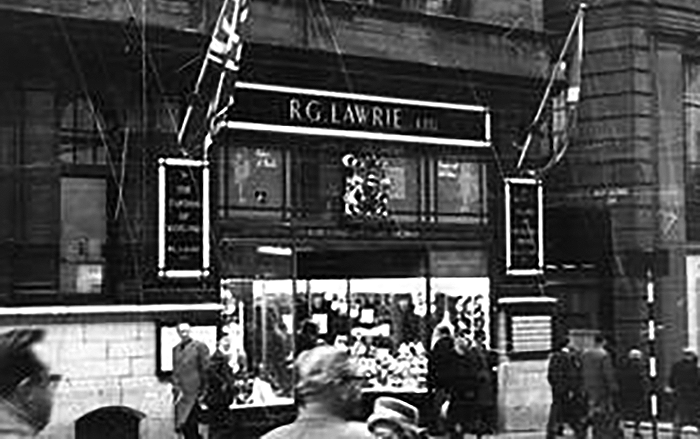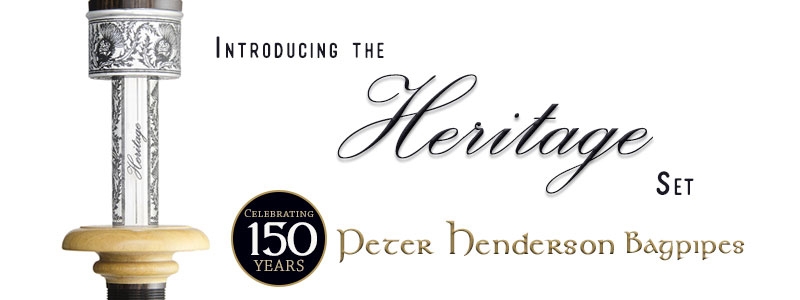We conclude this short history of the renowned bagpipe maker RG Lawrie. It is from the hand of its last proprietor, Arthur Lawrie. This history was given by Mr Lawrie to the late Jimmy McIntosh who kindly forwarded it to Piping Press. This article ends with a contemporary obituary for Mr Lawrie (2005). It sheds light on his personal life and his work with the company…

The independence of Tanganyika, now Tanzania, resulted in the collapse in the quality of African blackwood, coupled with a massive increase in price. As a result, once again ebony, this time from Gabon, started to be used for various parts of the drones and practice chanter tops.
Previously the supplier when cutting wood to size for the various bagpipe parts maintained a quality of blackwood density of a very even standard. The situation which now developed required a further skill from each bagpipe turner. The selection of wood he used depended on the quality of the bagpipe which he was making.
It has to be borne in mind that bagpipe prices in general terms related not to the quality of actual production or density of wood, but rather the degree and quality of ornamentation which essentially determined the price.
It was, however, incumbent upon the company to make quite certain that the more expensive a set of pipes was, so should the wood which went to its manufacture be totally flawless.
R.G. Lawrie himself supplied bagpipes to Queen Victoria which she presented to her son, later Edward VII. King George V bought several sets of bagpipes, not least of which was a miniature set for the Prince of Wales, later King Edward VIII.
The company received a Royal Warrant of Appointment to King George V in 1931. No Royal Warrant for bagpipe making was awarded to anyone by King George VI but the company did in fact receive a Royal Warrant from Her Majesty The Queen in 1957.

The company valued this honour very highly indeed, although by this time their other products – kilts and many thousands of military sporrans, to say nothing of Highland ornaments and, of course, bowling green bowls – were perhaps equal to the sale of bagpipes.
The retail business from shops in Glasgow and Edinburgh was undoubtedly the most profitable part of the company. Competition from dozens of private individuals in the bagpipe making field kept the price of instruments depressed below the market value of the product.
Thus, over the years, RG Lawrie placed the emphasis on retail sales and by 1977 there were a total of seven shops, two in Glasgow, one in Perth, one in Callander, one in Turnberry Hotel and two in Gleneagles Hotel. Turnover was over £1,000,000 and there were just over one hundred employees.
Family tree: Robert George Lawrie born 1848; started business 1881, died 1904. His sons were Robert Duncan Lawrie, Managing Director, died 1926 and James Brodie Lawrie, also Managing Director who died in 1961. Arthur Joseph Lawrie, born 1924, appointed Managing Director 1962, retired 1980, died 2005 aged 80.
Life and Times of Arthur Lawrie

COLONEL Arthur Lawrie was instrumental in building the name of RG Lawrie, the kilt and bagpipe makers into a worldwide brand.
Born in Cathcart, Glasgow, Lawrie began his military connection at Glasgow High School in the Officer Training Corps while simultaneously serving with the cadet force of the Cameronians. He volunteered for the Royal Marines at the age of 17.
Commissioned in February 1944, he served with 525th Assault Flotilla, and as a member of Amphibious Force W. He later served with SE Asia Command in Burma, Malaya, the Andaman Islands, Sumatra, Java, Bali and Lombok.
Lawrie did not wish to spend the rest of his life as an old soldier, relating tales of his action-packed service in SE Asia, but on his demobilisation in July 1946, he did become involved with the Territorial Army as a means of continuing his interest in military matters.
After service with the Highland Light Infantry (TA) he transferred to the newly formed Volunteer Reserve Marines in 1949. By the time he retired in 1967 as commander of the Royal Marines Reserve (Scotland) he had risen to the rank of Lt Colonel and had commanded. He was promoted to captain in 1953, major in 1959 and lieut colonel in 1963, which he held until his retirement in 1967. He was appointed Honorary Colonel Royal Marine Reserve (Scotland) in 1989, having been awarded the Volunteer Reserve Decoration in 1956.

His grandfather had established the family firm of RG Lawrie in 1881, employing skilled wood turners to make bagpipes and bowling green bowls in his original workshop in the John Street house where General Sir Colin Campbell – of Balaclava fame – had been born.
By the time of the Great Empire Exhibition in 1938, the company could justify six separate shops within the exhibition area as well as an exhibition stand.
When the 21-year-old lieutenant of Marines came home in July 1946, business was booming. As a result of the war, demand for kilts, bagpipes and other military equipment had soared and the workforce included five different categories of skilled craftsmen. Lawrie spoke sparingly of his wartime experiences and buckled down to learning about the much-changed business, of which he had known scarcely more than the exterior before he left Scotland.
Addressed as ‘Mr Arthur’, he worked his way up from labourer in the saw room in March 1947, to labourer in the dispatch department in his first year.
By year three, he was promoted to deputy assistant works manager and in March 1950, to works manager. He married Margaret Hamilton, a nurse in the Western Infirmary, that year.
His responsibilities covered the manufacture of bagpipes, kilts, tartan hose, sporrans, Highland ornaments (belts, badges, dirks etc) and bowling green bowls – heading a workforce of 84.
In 1961, his father – James Brodie Lawrie – died and ‘Mr Arthur’ was appointed chairman and managing director of R.G. Lawrie Ltd. Thereafter, as ‘Mr Lawrie’, he began to reap the rewards of the business ethic that he refined from his military training, not least of which was respect for the skills and morale of his workforce and determination to produce top quality merchandise to meet the aspiration of customers.

From the base of two shops and a factory which he had inherited, the business grew, with a new shop in Callander, Perthshire, even more prestigious premises in Buchanan Street and a completely new factory opened by Lord Clydesmuir in 1966.
The following three years saw further strategic consolidation and more dynamic export initiatives, making RG Lawrie Ltd the acknowledged experts on tartans worldwide and the largest company of its kind anywhere in the world.
By January 1980, the company had six shops dedicated to the up-market tourist trade at home – plus a main shop and three outlets in the Gleneagles Hotel complex – but a thriving business serving the world-wide demand for Highland dress.
They also held Royal Warrants of Appointment to the Sovereign and key members Royal Family whom they had supplied over the previous century In 1980, on reaching his 35th year with the family firm, Arthur Lawrie stood down as chairman and managing director, remaining a major shareholder.
Shortly thereafter, he was headhunted as managing director of Art Pewter Silver Ltd, a highly respected manufacturer of Scottish traditional jewellery – based in East Kilbride – whose quality products, RG Lawrie sold in all its own shops. After almost a decade, in which Lawrie increased Art Pewter’s sales worldwide, he retired yet again, but was retained as a consultant.
Arthur Lawrie was a remarkable person with a keen military mind plus a superlative and exhaustive knowledge of Scottish and military history, which he applied to a range of non-military challenges.
He extended kindness, good humour and common sense to all he met – friends, employees and customers – with adjustments for their shortcomings or those that might emerge.
He leaves a widow, Margaret, two married daughters and five grandchildren, who referred to the good colonel as ‘Funny Grandad’.
- Read the first part of this history here.
-
 Bagpipes – DN4A – High Quality Set in Plain Silver£200.00 – £2,052.00
Bagpipes – DN4A – High Quality Set in Plain Silver£200.00 – £2,052.00 -
 Bagpipes – DN5 – The Finest Bagpipe Available£300.00 – £3,424.00
Bagpipes – DN5 – The Finest Bagpipe Available£300.00 – £3,424.00 -
 Bagpipes – DN1, High Quality Instrument£100.00 – £1,250.00
Bagpipes – DN1, High Quality Instrument£100.00 – £1,250.00



















I recently inherited a set of old bagpipes that originally belonged to my great grand dad Hamish
Saunders (he passed in 1947 and left his pipes to my grandad) so they should be from before 1945ish…I have no idea how far before 1945 they could be.. they come in a wooden box and the box is marked
R.G. Lawrie
Highland House
60 Renfield St. Glasgow
Bagpipes Highland Costumes
the bag is not with it…but the family tartan (I assume) cover is….
any additional information you could add would be much appreciated